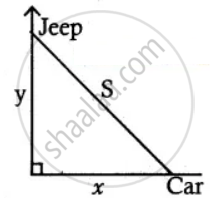Advertisements
Advertisements
Question
A police jeep, approaching an orthogonal intersection from the northern direction, is chasing a speeding car that has turned and moving straight east. When the jeep is 0.6 km north of the intersection and the car is 0.8 km to the east. The police determine with a radar that the distance between them and the car is increasing at 20 km/hr. If the jeep is moving at 60 km/hr at the instant of measurement, what is the speed of the car?
Solution

Given x = 0.8
y = 0.6
`("d"y)/"dt"` = – 60
`"ds"/"dtt"` = 20
From the figure
S2 = x2 + y2
S2 = (0.8)2 + (0.6)2
= 0.64 + 0.36
= 1
S2 = 1
⇒ S = 1
S2 = x2 + y2
Differentiating w.r.t. ‘t’
`2"S" "dS"/"dt" = 2x ("d"x)/"dt" + 2y ("d"y)/"dt"` .....(÷ 2)
`"S" "dS"/"dt" = x ("d"x)/"dt" + y ("d"y)/"dt"`
1(20) = `(0.8) ("d"x)/"dt" + (0.6)(- 60)`
20 = `0.8 ("d"x)/"dt" 36`
∴ `("d"x)/"dt" = (20 + 36)/0.8`
= `56/0.8`
= 70
∴ Speed of the car is 70 km/hr.
APPEARS IN
RELATED QUESTIONS
A particle moves along a straight line in such a way that after t seconds its distance from the origin is s = 2t2 + 3t metres. Find the instantaneous velocities at t = 3 and t = 6 seconds
A camera is accidentally knocked off an edge of a cliff 400 ft high. The camera falls a distance of s = 16t2 in t seconds. What is the average velocity with which the camera falls during the last 2 seconds?
A camera is accidentally knocked off an edge of a cliff 400 ft high. The camera falls a distance of s = 16t2 in t seconds. What is the instantaneous velocity of the camera when it hits the ground?
A particle moves along a line according to the law s(t) = 2t3 – 9t2 + 12t – 4, where t ≥ 0. At what times the particle changes direction?
A particle moves along a line according to the law s(t) = 2t3 – 9t2 + 12t – 4, where t ≥ 0. Find the total distance travelled by the particle in the first 4 seconds
If the mass m(x) (in kilograms) of a thin rod of length x (in metres) is given by, m(x) = `sqrt(3x)` then what is the rate of change of mass with respect to the length when it is x = 3 and x = 27 metres
A stone is dropped into a pond causing ripples in the form of concentric circles. The radius r of the outer ripple is increasing at a constant rate at 2 cm per second. When the radius is 5 cm find the rate of changing of the total area of the disturbed water?
A conical water tank with vertex down of 12 metres height has a radius of 5 metres at the top. If water flows into the tank at a rate 10 cubic m/min, how fast is the depth of the water increases when the water is 8 metres deep?
Find the points on curve y = x3 – 6x2 + x + 3 where the normal is parallel to the line x + y = 1729
Find the tangent and normal to the following curves at the given points on the curve
y = x2 – x4 at (1, 0)
Find the tangent and normal to the following curves at the given points on the curve
y = x4 + 2ex at (0, 2)
Find the tangent and normal to the following curves at the given points on the curve
y = x sin x at `(pi/2, pi/2)`
Find the tangent and normal to the following curves at the given points on the curve
x = cos t, y = 2 sin2t at t = `pi/2`
Find the equations of the tangents to the curve y = 1 + x3 for which the tangent is orthogonal with the line x + 12y = 12
Find the equation of tangent and normal to the curve given by x – 7 cos t andy = 2 sin t, t ∈ R at any point on the curve
Choose the correct alternative:
The volume of a sphere is increasing in volume at the rate of 3π cm3/ sec. The rate of change of its radius when radius is `1/2` cm
Choose the correct alternative:
A balloon rises straight up at 10 m/s. An observer is 40 m away from the spot where the balloon left the ground. The rate of change of the balloon’s angle of elevation in radian per second when the balloon is 30 metres above the ground
Choose the correct alternative:
The maximum slope of the tangent to the curve y = ex sin x, x ∈ [0, 2π] is at
